
One of the latest advances of cell phone technology is the wireless network extender, also known throughout the industry as a femtocell. With this new technology, mobile providers seek to capture a larger piece of the home telephone market.
What is a Wireless Network Extender?
Otherwise known as a "femtocell," the wireless network extender is a base unit that connects to the mobile provider's network through a home or business broadband Internet connection. This technology effectively "extends" the cellular network, because cell phones will work wherever there's a broadband Internet connection, even for areas where there's no cell phone signal. This is an ideal solution for cell phone customers who may not be able to get very good reception at home.
Features of Femtocell Technology
The infrastructure of such a network setup is as follows:
- A base station connects to your regular Internet broadband router
- The access point base station connects to your cell phone provider's network via the Internet
- The base station provides multiple cell phones in the home with a strong cell phone signal (typically over Wi-Fi)
- Some providers even offer a base station that allows regular home phones to make calls through the cell phone provider network
By offering this kind of technology to homeowners, many digital phone customers who want to eliminate the high cost of home phone service may opt for the cellular network access and cancel their home phone service completely. In this way, the cell phone industry is hoping to tap into the lucrative and profitable home communications market.
The Current State of Technology
This technology is still advancing, and there's currently no standard protocol, so whether it's available and how it's implemented depends greatly on the cellular provider. Below, you'll find more information about what the various providers offer in the form of a wireless network extender.
Sprint
Sprint was one of the first mobile providers that offered wireless network extender technology to customers. Sprint's version of this setup is called AIRAVE. The Sprint architecture works with any Sprint phone. Once the base station is set up in your home, your Sprint phone automatically detects the AIRAVE signal and will work as normal. Sprint even automatically transfers calls to the Sprint PCS network whenever you aren't home, or are out of range of the AIRAVE base station. Here are some of the features of the Sprint AIRAVE service.
- Works with a maximum of three cell phone users to a single base unit
- Sprint offers an unlimited calling plan for AIRAVE customers
- Transfers calls to the Sprint network when you're away from the base unit
- Uses your existing broadband Internet connection
- Provides the ability for low-speed data connections as well as voice
Verizon
Verizon was the next mobile provider to enter the market with its own in-home cellular solution, the Verizon Network Extender. This device, just like Sprint's solution, uses your home's broadband Internet connection and then transmits the cellular signal throughout your house, like a small, indoor cellular tower. It also listens for signals from your phone and transmits them through the Internet to the cellular network - essentially a hybrid cellular VoIP service. The capacity of Verizon's unit is an impressive 5,000 square feet.
AT&T
According to CNET and other news reports, AT&T is also seeking to follow the trend, but appears to be lagging behind the rest of the cellular providers. AT&T only just started testing femotocell technologies at the end of 2008, but promises to have a network extender solution utilizing the same sort of broadband technology as Sprint and Verizon by the end of 2009. In all cases, cellular providers offering such a solution to customers could potentially compete with current home VoIP digital services now offered by many cable companies. This move could be a way for the telecom industry to take back much of that market.
T-Mobile
T-Mobile is another major mobile provider that recently offered a Wi-Fi calling solution. T-Mobile's answer to the network extension challenge was to create special phones that work in conjunction with a router to make calls over a home's broadband network. While the service is a lot like what Sprint and Verizon offer, the technology utilizes a special selection of T-Mobile phones, not just any T-Mobile cell phone. In addition, T-Mobile is more integrated into the VoIP marketplace, and offers customers the option to make either purely VoIP phone calls or regular wireless calls. The service is called T-Mobile @ Home.
To Switch or Not To Switch
Switching to new technology can always be a scary thing. Many families cling to landlines because they desire the safety and security of a phone system that's independent of the power lines. This raises concerns regarding access to 911 emergency services, for example.
Many cable companies answered with VoIP routers that have battery backup, but consumers remain wary. Cellular phone companies face the same hurdles with their wireless network extender technology, because their routers will still depend upon household power. However, the significant monthly cost savings alone make it a bit easier for many families to swallow the tradeoff. In the end, your decision to give up the landline and only use your cell phone service may come down more to economic necessity than any sort of technological advantage. And, how often does the power really go out anyway?







